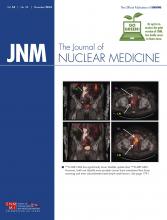TO THE EDITOR: We have recently published 2 articles about the use of 11C-MPDX (8-dicyclopropylmethyl-1-11C-methyl-3-propylxanthine) and PET for measurement of adenosine A1 receptor occupancy by nonradioactive agonists and antagonists (1,2). Dose-dependent occupancy of A1 receptors in the rodent brain by antagonists (caffeine, DPCPX [1,3-dipropyl-8-cyclopentyl xanthine]) could be assessed, but administration of an exogenous agonist (CPA [N6-cyclopentyladenosine]) or raising the levels of endogenous adenosine by treating animals with ethanol and the adenosine kinase inhibitor ABT-702 (4-amino-5-(3-bromophenyl)-7-(6-morpholino-pyridin-3-yl)pyrido[2,3-d]pyrimidine) did not result in measurable competition of agonist and tracer. A paradoxic increase of tracer uptake was observed under these conditions. Kinetic modeling of the PET data suggested that there was an increase in tracer binding potential rather than in tracer delivery to the brain or passage of the tracer across the blood–brain barrier. This phenomenon was unexpected and could not be explained.
At the recent Purines 2014 meeting in Bonn, a possible explanation was offered by Drs. Andreas Bauer (Düsseldorf, Germany) and Renata Ciccarelli (Chieti, Italy). These experts pointed out that many ligands for adenosine A1 receptors that initially were considered antagonists are in fact inverse agonists. Inverse agonism has been proven for WRC-0571 (8-(N-methylisopropyl)amino-N6-(5′-endohydroxy-endonorbornyl)-9-methyladenine) (3), CGS-15943 (9-chloro-2-(furan-2-yl)-[1,2,4]triazolo[1,5-c]quinazolin-5-amine) (3), DPCPX (3), and CPFPX (8-cyclopentyl-(3-(3-fluoropropyl)-1-propylxanthine) (4). The last 2 ligands are structurally similar to our tracer, MPDX.
Inverse agonists such as DPCPX display a high affinity for the uncoupled, or inactive, state of the A1 receptor and a lower affinity for the G-protein–coupled state (5). Paradoxic increases in 11C-MPDX binding in the rodent brain on administration of CPA or treatment of rats with ethanol and adenosine kinase inhibitor may therefore be explained in the following way: agonists (such as CPA or adenosine) increase the fraction of A1 receptors in the uncoupled state, because the ternary complex consisting of agonist, activated receptor, and G-protein is not stable in living tissue. Guanosine triphosphate binding results in decoupling of the G-protein from the complex and relaxation of the receptor to the inactive conformation, possessing low affinity for the agonist but high affinity for an inverse agonist such as 11C-MPDX. Thus, the binding potential for 11C-MPDX is increased after administration of a pharmacologic dose of an agonist. An increase (23%–55%) similar to that we observed for 11C-MPDX binding in the rodent brain after agonist treatment was seen for 3H-DPCPX binding in human brain slices on the addition of guanosine triphosphate (6).
This hypothesized explanation of our PET findings could be tested by radiolabeling a neutral antagonist and repeating the experiments with that tracer. Binding of an antagonist tracer should not be increased in the presence of an excess of agonist, in contrast to binding of an inverse agonist such as 11C-MPDX or 18F-CPFPX. To achieve this goal, a neutral antagonist with nanomolar affinity should be developed that is amenable to labeling (7). It may also be possible to use the nonxanthine PET tracer 11C-FR194921 (11C-2-(1-methyl-4-piperidinyl)-6-(2-phenylpyrazolo[1,5-a]pyridin-3-yl)-3(2H)-pyridazinone (8).
Footnotes
Published online Oct. 9, 2014.
- © 2014 by the Society of Nuclear Medicine and Molecular Imaging, Inc.







